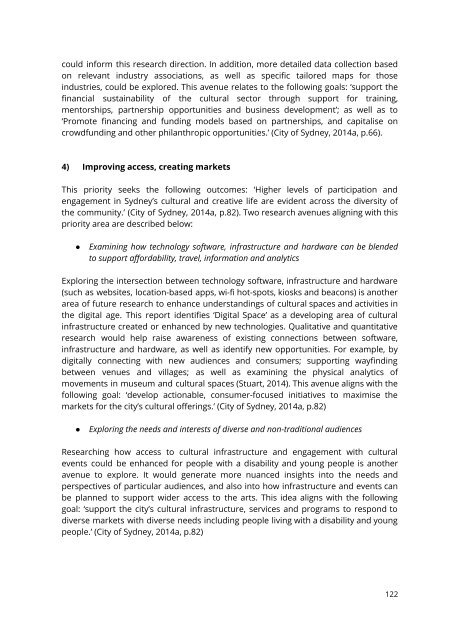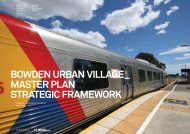MAPPING CULTURE
Mapping-Culture-Venues-and-Infrastructure-in-the-City-of-Sydney
Mapping-Culture-Venues-and-Infrastructure-in-the-City-of-Sydney
Create successful ePaper yourself
Turn your PDF publications into a flip-book with our unique Google optimized e-Paper software.
could inform this research direction. In addition, more detailed data collection based<br />
on relevant industry associations, as well as specific tailored maps for those<br />
industries, could be explored. This avenue relates to the following goals: ‘support the<br />
financial sustainability of the cultural sector through support for training,<br />
mentorships, partnership opportunities and business development’; as well as to<br />
‘Promote financing and funding models based on partnerships, and capitalise on<br />
crowdfunding and other philanthropic opportunities.’ (City of Sydney, 2014a, p.66).<br />
4) Improving access, creating markets<br />
This priority seeks the following outcomes: ‘Higher levels of participation and<br />
engagement in Sydney’s cultural and creative life are evident across the diversity of<br />
the community.’ (City of Sydney, 2014a, p.82). Two research avenues aligning with this<br />
priority area are described below:<br />
●<br />
Examining how technology software, infrastructure and hardware can be blended<br />
to support a 齰〗 ordability, travel, information and analytics<br />
Exploring the intersection between technology software, infrastructure and hardware<br />
(such as websites, location-based apps, wi-fi hot-spots, kiosks and beacons) is another<br />
area of future research to enhance understandings of cultural spaces and activities in<br />
the digital age. This report identifies ‘Digital Space’ as a developing area of cultural<br />
infrastructure created or enhanced by new technologies. Qualitative and quantitative<br />
research would help raise awareness of existing connections between software,<br />
infrastructure and hardware, as well as identify new opportunities. For example, by<br />
digitally connecting with new audiences and consumers; supporting wayfinding<br />
between venues and villages; as well as examining the physical analytics of<br />
movements in museum and cultural spaces (Stuart, 2014). This avenue aligns with the<br />
following goal: ‘develop actionable, consumer-focused initiatives to maximise the<br />
markets for the city’s cultural offerings.’ (City of Sydney, 2014a, p.82)<br />
●<br />
Exploring the needs and interests of diverse and non-traditional audiences<br />
Researching how access to cultural infrastructure and engagement with cultural<br />
events could be enhanced for people with a disability and young people is another<br />
avenue to explore. It would generate more nuanced insights into the needs and<br />
perspectives of particular audiences, and also into how infrastructure and events can<br />
be planned to support wider access to the arts. This idea aligns with the following<br />
goal: ‘support the city’s cultural infrastructure, services and programs to respond to<br />
diverse markets with diverse needs including people living with a disability and young<br />
people.’ (City of Sydney, 2014a, p.82)<br />
122



